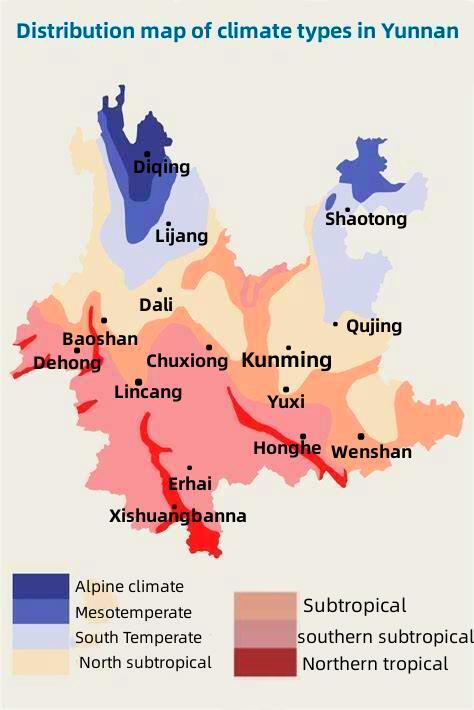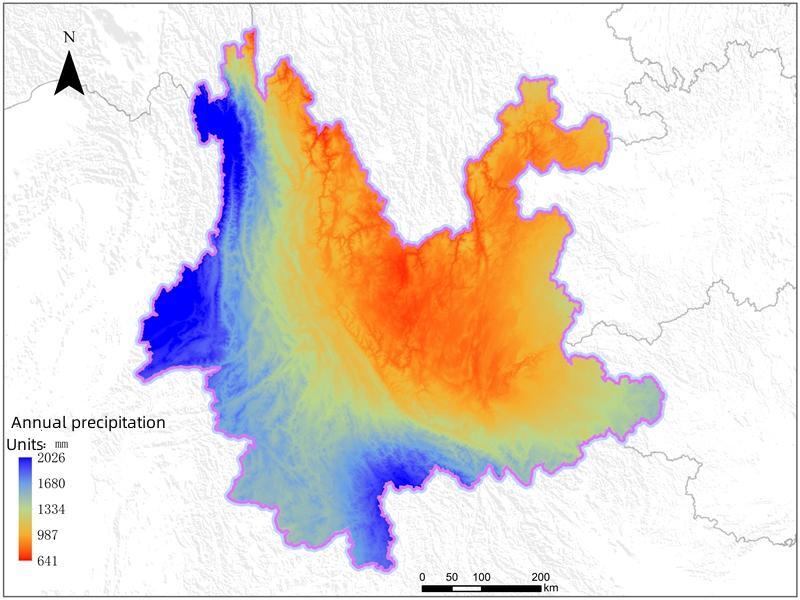
Yunnan is a low-latitude province with a distinctive geographic location and complex topography, so the climate is also unique. From the whole aspect, north of the vast Asian continent, south of the vast Bay of Bengal (distance of less than 700 kilometers) and the South China Sea (distance of less than 400 kilometers), just in the East Asian monsoon and the South Asian monsoon convergence area, and the northwest of the Tibetan Plateau by the influence of the terrain, the formation of complex and diverse climatic conditions. The climate of Yunnan is rich and varied, with seven climate types: northern tropical, southern subtropical, central subtropical, northern subtropical, southern temperate, mesothermal, and plateau climate zones.
Northwest Yunnan has a frigid, long winter without summer, spring and autumn are shorter; East, middle of Yunnan is a temperate climate, with four seasons like spring, when the rain into the winter; South, southwestern Yunnan is a low-heat valley area, a part of the Tropic of Cancer in the south of the Tropic of Cancer, into the tropical range, long summer without winter, rain into the autumn. In this provincial area, at the same time with a cold, warm, hot climate, generally every 100 meters above sea level, the average temperature decreases by 0.6 to 0.7 ℃, a “mountain divided into four seasons, ten miles of different days,” said, the scene is unique. The average temperature of province, the hottest (July) monthly average temperature between 19 to 22 ℃, the coldest (January) monthly average temperature between 6 to 8 ℃, the annual temperature difference is generally only 10 to 12 ℃. Colder in the morning and evening and hot at noon, especially in winter and spring, the daily temperature difference can reach 12 ~ 20℃. Therefore, the climate in Yunnan varies a lot, and as the climate changes, you can see different scenery changes.
Temperature difference in four seasons in Yunnan | ||||
|
Spring |
Summer |
Autumn |
Winter |
Kunming Day Night |
15-25 ℃ |
20-27 ℃ |
15-23 ℃ |
5-15 ℃ |
Dali Day Night |
15-25 ℃ |
23-28 ℃ |
15-20 ℃ |
10-15 ℃ |
Xishuangbanan |
15-31 ℃ |
22-31 ℃ |
21-30 ℃ |
13-25 ℃ |
Lijiang |
5-20 ℃ |
10-26 ℃ |
5-23 ℃ |
0-15 ℃ |
Shangri-La |
5-20 ℃ |
15-26 ℃ |
10-23 ℃ |
2-12 ℃ |

Most of Yunnan is in the rainy season, and the distribution of precipitation in the province is very uneven in season and geographically. Precipitation is mainly during the summer, mainly in Nujiang, Diqing, Dali, Lijiang, and other areas. The wet and dry seasons are distinct, with the rainy season from May to October, which concentrates 85% of the rain. The dry season is from November to April, with precipitation accounting for only 15% of the year. Precipitation varies across the province, of which Ximeng is the city with the most precipitation in Yunnan, with annual rainfalls as high as 2200-2700 mm. The lowest precipitation in Binchuan is 584 mm, and the annual rainfall in most areas is more than 1000 mm. When traveling during the rainy season, it is very of great importance to choose a suitable tour. Generally speaking, you can prefer to travel to areas such as the west and north where there is less rainfall, like Xishuangbanna, Dali, and Lijiang, avoiding areas such as Kunming, Honghe, and Yuxi. Some outdoor attractions, such as Yunnan Stone Forest, Tiger Leaping Gorge, and Lugu Lake, are less suitable for tourists due to the slippery ground during the rainy season.
One of the advantages of the weather in Yunnan is its mild and pleasant temperatures, especially in popular tourist destinations such as Kunming, Dali, Lijiang, and Shangri-La. The moderate climate makes it comfortable for travelers to explore the natural wonders, cultural sites, and outdoor activities.
Kunming has four warm seasons, with a mild temperature difference throughout the year. The average annual temperature in the urban area is around 15℃, with an average monthly temperature of 19℃ at the hottest month and 6℃ at the coldest time. The temperature of Dali throughout the year is roughly like this: Dali has four seasons, with temperatures ranging from 10 degrees to 25 degrees Celsius, and basically does not have four seasons, spring, summer, fall, and winter, but is mainly divided into the dry season and the rainy season. The rainy season is from the end of May to the end of November, and the dry season is from early December to early May of the following year.
The weather in Lijiang varies throughout the year: Lijiang has a slight annual temperature difference, a significant daily temperature difference, a large indoor-outdoor temperature difference, and high UV rays. The weather in Lijiang is a highland climate with a big difference in temperature between morning and evening. Usually wear a thick coat or down jacket in the morning and evening (even in summer). It is okay to wear short-sleeved T-shirts and super-short skirts during the day (even in winter), but you should always bring your jacket in case an unexpected change in weather causes a cold. When you go to Lijiang in March or April in spring, you can visit the old town in Lijiang, and the weather is mild, and you can usually wear a thin jacket on sunny days and a sweater on rainy days. Go to Lijiang in May, it is the time when Lijiang flowers are in full bloom, with bright colors, and it is a perfect time to enjoy the flowers. The weather is sunny, and you can usually wear short sleeves.
The weather in Yunnan also contributes to the stunning natural beauty of the province, with its snow-capped mountains, crystal-clear lakes, lush forests, and vibrant flowers. The picturesque landscapes, accentuated by the changing seasons, provide a breathtaking backdrop for tourists to immerse themselves in nature and capture unforgettable moments.




































